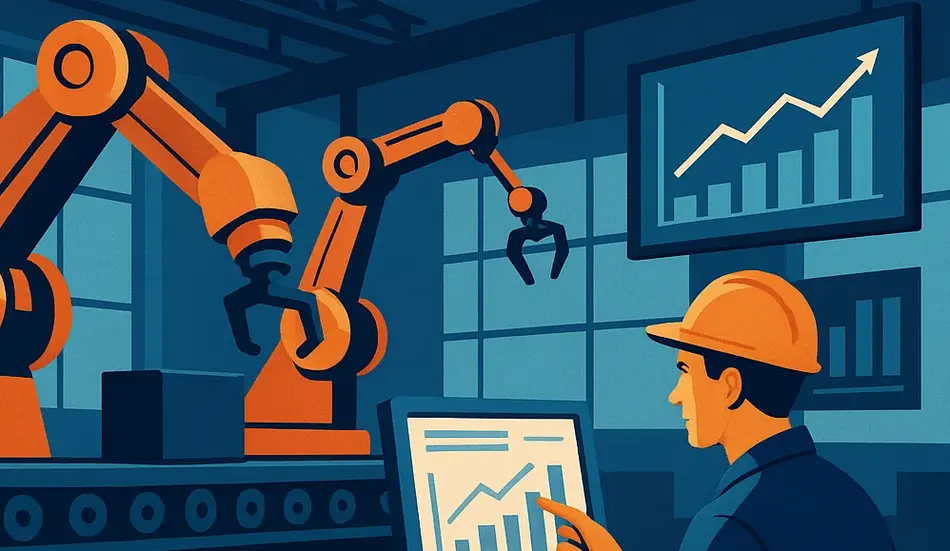As U.S. manufacturers contend with persistent labor shortages, rising production costs, and intensifying global competition, automation has leapt from a strategic advantage to an existential necessity. Advanced robotics, artificial intelligence (AI), and connected “smart factory” systems are not only boosting productivity but fundamentally reshaping the workforce—eliminating some traditional roles while creating new, higher-skill positions.
1. The Reshoring Imperative Meets Automation
After decades of offshoring, policy initiatives such as the CHIPS and Science Act, the Inflation Reduction Act, and infrastructure investments have spurred a wave of reshoring. But simply bringing plants back to U.S. soil isn’t enough: American factories must match or exceed the efficiency of lower-cost regions. As a result, 78% of manufacturers now devote over 20% of their improvement budgets to smart-factory technologies—integrating sensors, analytics, and machine-learning to optimize operations in real time Rockwell Automation.
Building Smarter Factories?
Reshoring success depends on talent that understands automation. Post your manufacturing and tech-forward roles on WhatJobs to connect with engineers, technicians, and AI-savvy operators ready to power the next-gen smart factory.
Hire for Smart Manufacturing Now2. From “Dirty, Dull, and Dangerous” to Technical Expertise
2.1 Displacement of Routine Tasks
Robots and cobots (collaborative robots) have taken on the manual assembly, heavy lifting, and repetitive inspection tasks that once defined many entry-level roles. In shipbuilding, for example, exoskeletons and virtual-reality welding simulators at a Wisconsin yard have cut manual labor hours by 40%, while also requiring workers to reach new technical proficiencies Financial Times
2.2 Surge in Technical and Analytical Roles
As routine tasks disappear, demand is soaring for technicians, programmers, and data analysts who can install, maintain, and troubleshoot automated systems. The Manufacturing Institute projects 2.1 million unfilled jobs by 2030 due to a shortage of automation-capable workers Morningstar. Starting salaries for automation specialists now often exceed $80,000, with many roles accessible via certificates or associate degrees rather than four-year STEM degrees.
3. Regional and Sectoral Variations
- Automotive and Heavy Industry: Long a leader in robotics, the automotive sector saw North American robot orders hold steady in Q1 2025 despite broader economic headwinds; manufacturers are deploying machine-vision systems for quality control and automated guided vehicles on assembly floors Financial Times.
- Electronics and Semiconductors: In high-clean-room fabs, AI-driven defect inspection has slashed scrap rates by up to 25%, accelerating cycle times and reducing waste.
- Fabricated Metals and Furniture: These smaller-scale industries lag in robot density due to capital barriers, risking competitive disadvantages as larger players automate more aggressively.
Geographically, Rust Belt hubs (e.g., Detroit, Cleveland) are leading in cobot installations, while Sunbelt states (Texas, Tennessee) are erecting new “gigafactories” designed with automation and digital twins baked in from day one www.whatjobs.com.
4. Case Studies Illustrating Transformation
- Fincantieri Wisconsin Shipyard: Introduced gantry robots and exosuits, cutting manual welding hours by 40% and boosting technical-training enrollments by 60% Financial Times.
- Detroit Tier-1 Automotive Supplier: Deployed automated guided vehicles and machine-vision lines, reducing defects by 30% and retraining 200 assembly workers as sensor-network supervisors.
- Phoenix Electronics Shop: Adopted modular cobot cells for PCB assembly, doubling output without increasing headcount and shifting workers into “cobot supervisor” roles.
5. The Skills Gap and Workforce Development
5.1 Training Infrastructure Strains
Community colleges and technical schools struggle to scale curricula for robotics programming, PLC (programmable logic controller) operation, and industrial cybersecurity. Without expanded training pipelines, the projected 3.8 million new manufacturing jobs by 2033 may leave nearly half unfilled LinkedIn.
5.2 Industry and Policy Responses
- Federal Grants: The Infrastructure and Jobs Act earmarked $15 billion for workforce-development, including automation-focused training programs.
- Consortia Initiatives: Groups like MFG Works and the Smart Manufacturing Coalition partner with manufacturers to create standardized credential pathways.
- Corporate Training Hubs: Firms such as Rockwell Automation have opened regional centers to teach smart-factory technologies to employees and community members alike Rockwell Automation.
6. Cybersecurity: The New Frontier
Smart factories—rife with IoT sensors and cloud platforms—expand the attack surface for industrial espionage and ransomware. As a result, demand is increasing for roles in industrial-control cybersecurity and network monitoring. Companies are investing in enterprise-grade firewalls, encrypted communications, and intrusion-detection systems to safeguard both IP and worker safety NIST.
7. Economic and Social Implications
7.1 Productivity and Competitiveness
Automation has delivered double-digit productivity gains in many sectors, enabling U.S. manufacturers to compete on quality and lead times rather than just cost.
7.2 Workforce Equity Concerns
There is a risk that blue-collar communities may be left behind if retraining efforts falter. Policymakers and industry must ensure equitable access to automation careers, including outreach in rural and economically distressed regions.
Frequently Asked Questions (FAQ)
Will robots eliminate most manufacturing jobs?
No. While automation displaces routine roles, it creates higher-skill positions in programming, maintenance, and analytics. Net job growth depends on successful upskilling and training initiatives.
What skills are most in demand?
Proficiency in robotics operation, PLC programming, data analysis, and industrial cybersecurity top the list. Many positions require post-secondary certificates rather than four-year degrees.
How can workers prepare?
Enroll in community-college courses on industrial automation, pursue apprenticeships sponsored by regional manufacturers, and leverage federal workforce grants for training.
Are small manufacturers benefiting?
Yes—modular cobot solutions and robotics-as-a-service models allow smaller shops to automate incrementally, boosting efficiency without massive capital outlays.
What about cybersecurity risks?
Smart factories introduce new vulnerabilities. Demand is rising for specialists in industrial-control security, and companies must implement layered defenses—encryption, network segmentation, and continuous monitoring.
Conclusion
Automation is transforming U.S. manufacturing from the shop floor to the C-suite. Success hinges on aligning reshoring efforts with smart-factory investments, expanding training pipelines to close the skills gap, and fortifying cybersecurity. By embracing these changes, American industry can harness automation’s productivity gains while fostering a resilient, high-skilled workforce.




